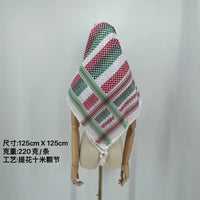The white Arabian square scarf carries a wealth of symbolic meanings in Arab culture, in addition to being a traditional garment and a status symbol. The following is a detailed description of these symbolism:
First, purity and elegance
White is generally regarded as a symbol of purity and elegance in Arab culture. Wearing a white Arabian scarf men, often given the image of good conduct, decent behavior. This color choice not only reflects the Arab's respect for their own culture, but also shows their attitude of pursuing noble character and elegant life.
Second, practicality and functionality
In the Arab region, especially in the desert area, the white Arabian scarf also has significant practicality and functionality. Its light-colored characteristics help reflect the sunlight, reduce head temperature and prevent heat stroke. At the same time, the hijab covers the neck and face from sandstorms and UV rays. This practicality makes the white Arabian square scarf indispensable in the daily life of Arabs.
Third, cultural identity and national sentiment
Wearing the white Arabian scarf is an important manifestation of Arab cultural identity and national sentiment. Through this traditional dress, Arabs can express their love and inheritance of traditional culture, and at the same time can also show their national pride and sense of belonging. In the important occasions and festivals in Arab countries, wearing a white headscarf has become a traditional custom and etiquette.

Fourth, the social class and status symbols (some countries)
It should be noted that although the white Arab square scarf is widespread in the Arab region, in some countries there may be differences in the texture, pattern and wearing style of the headscarf worn by people of different classes and status. For example, in some countries, nobles and royalty may wear more elaborate and ornate white headscarves to emphasize their status. However, such differences are not universal in all Arab countries and therefore need to be analyzed on a case-by-case basis.

Fifth, the imprint of history and religion
The white Arabian square scarf also carries the imprint of Arab history and religion. In Islam, men are required to dress modestly, covering all parts of the body between the waist and the knees. Therefore, wearing the white hijab has also become a sign of the Arab male's adherence to the teachings of the religion. At the same time, the way the headscarf is worn also reflects the Arab's respect for and transmission of historical traditions.

In summary, the white Arabian turban has multiple symbolic meanings in Arab culture, including purity and elegance, practicality and functionality, cultural identity and national sentiment, symbols of social class and status (in some countries), and historical and religious imprints. These symbolisms together constitute the rich and colorful connotation and unique charm of Arab culture.





